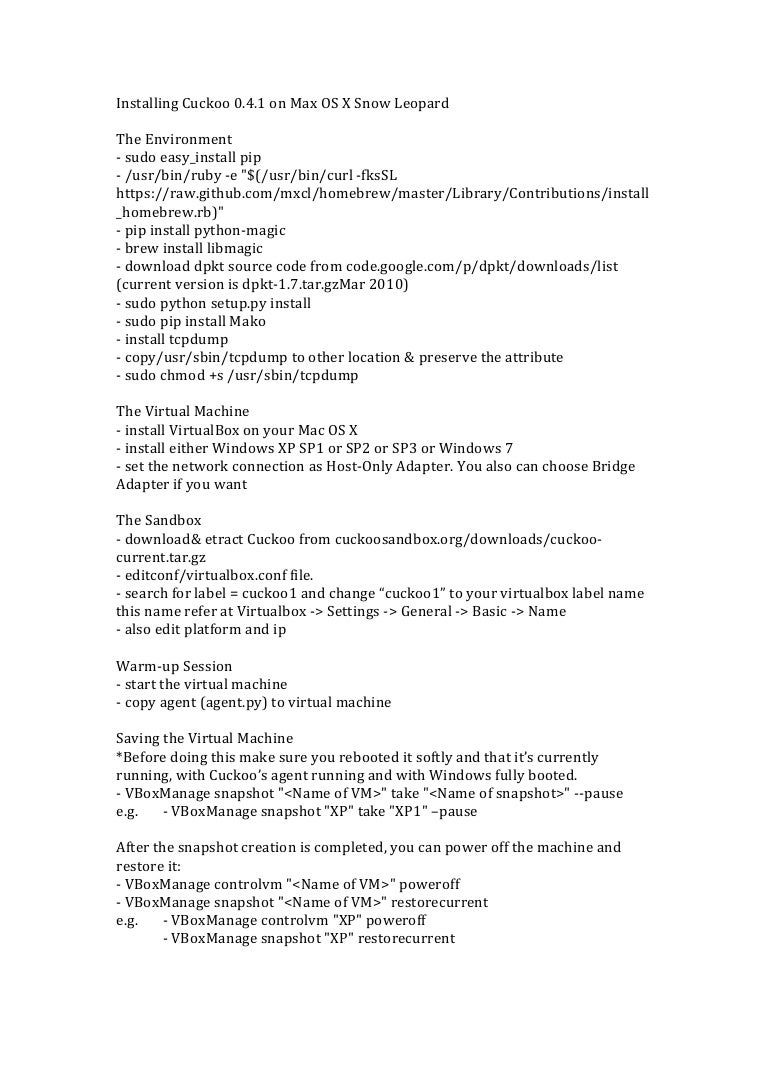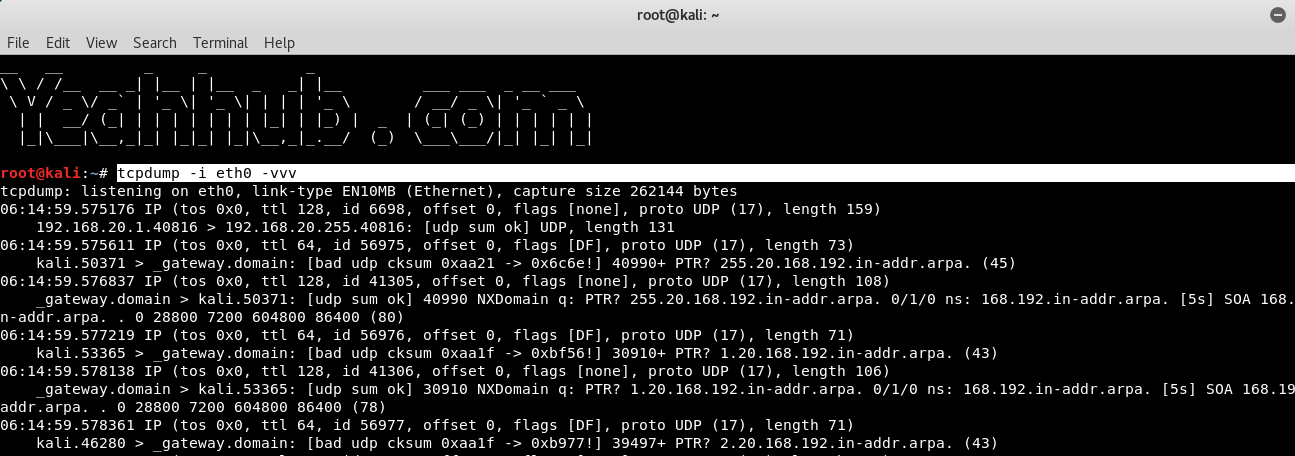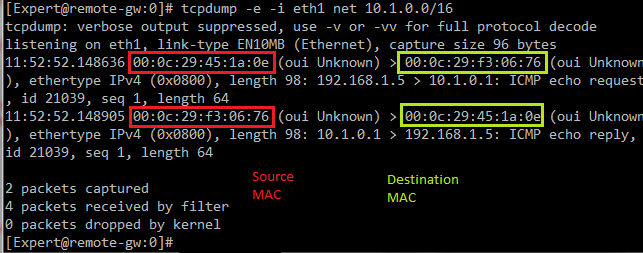Sniffing on the linux machine
Tcpdump Filters To filter for a specific host, append host and the IP address to the tcpdump command. To filter for host 192.168.1.100 use the following command: That will capture all traffic to and from that host. Similarly, filtering for traffic destined to that IP address is possible by specifying dst. Compatibility: Microolap TCPDUMP for Windows ® is fully UEFI and Secure Boot compatible. Here is a list of the Windows family operating systems supported by Microolap TCPDUMP for Windows ®: Windows XP, WinXP x64, Windows Vista, Vista x64, Windows 2003, Win2003 x64, Windows 2008, Windows 2012, Windows 8, Windows 10, Windows Server 2016, Windows server 2019, and various Windows PE versions. Install python3 from your package manager if it is not already present; Install tcpdump and make sure it is in the $PATH. (It’s only used to compile BPF filters (-ddd option)) Make sure your kernel has Packet sockets selected (CONFIGPACKET). To install it run: python -m pip install -upgrade tox Visit development page. Installation from sources: clone the sources: git clone libpcap and run: python -m pip install./libpcap or on development mode: python -m pip install -editable./libpcap License. Tcpdump for windows free download - Microsoft Office 2011, Adobe Photoshop CC, uTorrent, and many more programs. Enter to Search. My Profile Logout. Install Windows using Intel devices.
Capturing a sniffer dump on a linux machine is easy, we can install the tcpdump package to capture network packets and write these to a file for further analysis with wireshark.
- apt-get install tcpdump
- tcpdump -i <interface> -s 65535 -w <some-file>
You can transfer the file thereafter with WinSCP to your Windows station for analysis.
Sniffing on the linux machine with redirection to your Windows wireshark
If you have putty and plink installed, you can also capture directly on a remote linux machine and redirect this to your windows station’s wireshark for realtime analysis.

If you are using password authentication on the linux machine:
- “C:Program Files (x86)PuTTYplink.exe” -ssh -pw password root@somemachine.localdomain tcpdump -n -nn -s 0 -U -w – -i bfe0 vlan 99 and icmp | “C:Program FilesWiresharkwireshark.exe” -i – -k
Or if you’re using key based authentication:


- “C:Program Files (x86)PuTTYplink.exe” -ssh -i “C:mykeystoresomekey.ppk” root@somemachine.localdomain tcpdump -n -nn -s 0 -U -w – -i bfe0 vlan 99 and icmp | “C:Program FilesWiresharkwireshark.exe” -i – -k
The tcpdump utility allows you to capture packets that flow within your network to assist in network troubleshooting. The following are several examples of using tcpdump with different options. Traffic is captured based on a specified filter. A variety of options exist, including:
| Options | Description |
|---|---|
| -D | Print a list of network interfaces. |
| -i | Specify an interface on which to capture. |
| -c | Specify the number of packets to receive. |
| -v, -vv, -vvv | Increase the level of detail (verbosity). |
| -w | Write captured data to a file. |
| -r | Read captured data from a file. |
Installing tcpdump utility
On most of the unix/linux systems you would not find the tcpdump package already installed. To install the latest version use the appropriate package manager on your system. For example, In case of CentOS/RHEL servers:

Examples of using tcpdump for network troubleshooting
1. Display list of network interfaces
To print a list of network interfaces available on which tcpdump can capture packets:
How To Install Tcpdump For Mac High Sierra
2. Capturing on a specific interface
As seen from the ‘tcpdump -D’ command, for each network interface, a number and an interface name is printed. The interface name or the number can be supplied to the -i flag to specify an interface on which to capture. For example, to capture the packets on the interface eth0:
In this example, the output is continuous until terminated by pressing Ctrl + C.
3. Capture a specific number of packets only
To exit tcpdump after receiving a specific number of packets, use the -c (count) option followed by the number of packets to receive. The following example captures two packets:
As shown in this example, when tcpdump finishes capturing packets, it reports the following:
How To Install Tcpdump For Mac Os
- packets captured: This is the number of packets that tcpdump has received and processed.
- packets received by filter: A filter can be specified on the command line and only those packets that match the defined filter are processed by tcpdump and counted.
- packets dropped by kernel: This is the number of packets that were dropped due to a lack of buffer space. Use the -B option to set the buffer size.
4. Increase the details (verbosity) of the output
To increase the detail (verbosity) of the output, use the -v option, or -vv for even more verbose output, or -vvv for the most verbose level of output:
5. Capture the data to a file
Using the tcpdump utility with the -w option allows you to write captured data to a file. This allows the captured data to be read by other network analysis tools, such as Wireshark. The following example captures data to a file named capture.out:
6. reading captured data
You can also read captured data from a file by using the –r option:
Some more examples of tcpdump command
Many other options and arguments can be used with tcpdump. The following are some specific examples of the power of the tcpdump utility.
1. Display traffic between 2 hosts
To display all traffic between two hosts (represented by variables host1 and host2):
2. Display traffic from a source or destination host only
To display traffic from only a source (src) or destination (dst) host:
3. Display traffic for a specific protocol
Provide the protocol as an argument to display only traffic for a specific protocol, for example tcp, udp, icmp, arp:
For example to display traffic only for the tcp traffic :
4. Filtering based on source or destination port
To filter based on a source or destination port:
The tcpdump utility also accepts Boolean operators (AND, NOT, OR) and grouping of operators, allowing you to create complex filters for capturing network data.
